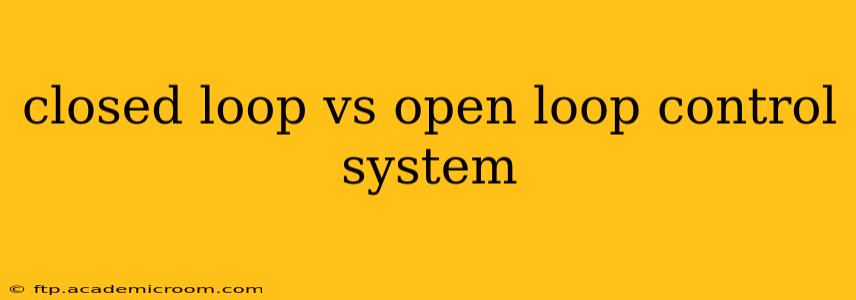Understanding the difference between closed-loop and open-loop control systems is crucial for anyone working with automation, robotics, or any system requiring precise control. This comprehensive guide will explore the core principles, advantages, disadvantages, and real-world applications of each, answering frequently asked questions along the way.
What is an Open Loop Control System?
An open-loop control system, also known as a non-feedback control system, operates without feedback from the controlled process. Essentially, it follows a predetermined path without monitoring the actual output. The control action is independent of the output. Think of it like setting a timer on an oven – you input the desired time, and the oven heats for that duration regardless of whether the food reaches the target temperature.
Key Characteristics of Open Loop Systems:
- Simple design and implementation: They are generally less complex and cheaper to implement than closed-loop systems.
- No feedback mechanism: The system doesn't measure the output and compare it to the desired value.
- Susceptible to disturbances: External factors can significantly affect the accuracy and performance.
- Suitable for simple processes: Best used when precise control isn't critical, and the process is relatively predictable.
What is a Closed Loop Control System?
A closed-loop control system, also known as a feedback control system, uses feedback from the controlled process to adjust the control action. This feedback allows the system to continuously monitor the output and compare it to the desired setpoint. Any deviation triggers corrective action to bring the output back to the target. Think of a cruise control system in a car – it constantly monitors the vehicle's speed and adjusts the throttle to maintain the set speed.
Key Characteristics of Closed Loop Systems:
- High accuracy and precision: They are capable of maintaining a desired output even in the presence of disturbances.
- Self-correcting: Feedback mechanisms enable the system to automatically adjust to changes and maintain stability.
- More complex design: Generally more expensive and require more sophisticated components.
- Suitable for complex processes: Ideal for applications requiring tight control and precise output.
What are the Advantages and Disadvantages of Each System?
| Feature | Open Loop System | Closed Loop System |
|---|---|---|
| Cost | Lower | Higher |
| Complexity | Simpler | More Complex |
| Accuracy | Lower; susceptible to disturbances | Higher; self-correcting |
| Stability | Less stable; prone to errors | More stable; maintains setpoint despite disturbances |
| Maintenance | Easier to maintain | More complex maintenance |
| Applications | Simple processes, predictable environments | Complex processes, requiring precise control |
What are some real-world examples of open-loop and closed-loop systems?
Open Loop Examples:
- Washing machine timer: The machine operates for a predetermined time, regardless of the cleanliness of the clothes.
- Traffic light system: The lights change according to a pre-programmed schedule, regardless of traffic flow (although some advanced systems incorporate basic feedback).
- A simple sprinkler system: Operates based on a timer, regardless of soil moisture.
Closed Loop Examples:
- Cruise control in a car: Monitors speed and adjusts throttle accordingly.
- Thermostat: Regulates temperature by turning heating/cooling on and off based on the measured temperature.
- Automatic gain control (AGC) in an amplifier: Adjusts the gain to maintain a constant output level.
How does feedback work in a closed-loop system?
Feedback in a closed-loop system involves measuring the output of the controlled process and comparing it to the desired setpoint (the target value). The difference between the actual output and the setpoint is the error signal. A control algorithm processes this error signal and generates a control action to reduce the error and bring the output closer to the setpoint. This process happens continuously, ensuring accurate control.
What are the different types of closed-loop control systems?
There are several types of closed-loop control systems, each with its own characteristics and applications. These include Proportional (P), Integral (I), Derivative (D), and combinations like Proportional-Integral (PI), Proportional-Integral-Derivative (PID) controllers, which are widely used in industrial process control. The choice of controller depends on the specific application and the dynamics of the controlled process.
Which system is better, open-loop or closed-loop?
There is no universally "better" system. The choice between an open-loop and closed-loop system depends entirely on the specific application and its requirements. Open-loop systems are suitable for simple processes where precise control is not crucial, while closed-loop systems are necessary for applications demanding high accuracy and stability in the face of disturbances. The trade-off is always between simplicity and cost versus precision and stability.
